By Steve Benjamin, Head of Market and Business Intelligence at Fidelity Institutional.
“There are more assets transitioning away from traditional fixed income and chasing other forms of yield, which is driving those assets’ yields even further down. I think there [are] less and less safe yielding assets, so you are being pushed to take more risk to generate any yield.”
CIO, Innovator/Early Adopter, Endowment & Foundation, less than $1B AUM
“As a company, we are somewhat conservative. We don’t want to be the innovators; we don’t want to be the trailblazers … We don’t want to be the company that says, ‘We did it first.’ We don’t care about that. When the rest of the world is happy, when it has been proven, then we will do it.”
Benefits Director, Laggard, Corporate Defined Benefit, less than $1B AUM
“We have formal efforts to learn and understand about new and emerging areas. And about areas where we perceive there to be significant changes. We’re always open to ideas and have some intellectual curiosity both culturally and again in a formal fashion.”
CIO, Innovator/Early Adopter, Corporate Defined Benefit, $5B to less than $10B AUM
Key Takeaways
- Benchmarking portfolio and organizational performance against peers is a critical success measure for institutions today. While organization type and size are commonly used to define peer groups, layering in a new dimension around innovation can further refine these definitions and lead to meaningful insights.
- By using a framework, we call the Investment Innovators Curve, institutional executives can assess their organization’s ability and willingness to experiment with new investment approaches or asset classes.
- Research from our Institutional Investor Innovation Study reveals that firms placing themselves at either end of the curve differ with regard to performance expectations, portfolio structure and management, and internal versus external relationship building.
- Institutions that know where their firm’s investment culture and processes fall on the innovators curve can better understand the trade-offs associated with their philosophy and plan for how these will impact their decision-making in a looming low-return environment.
Fidelity U.S. Institutional Investor Innovation Study by the Numbers
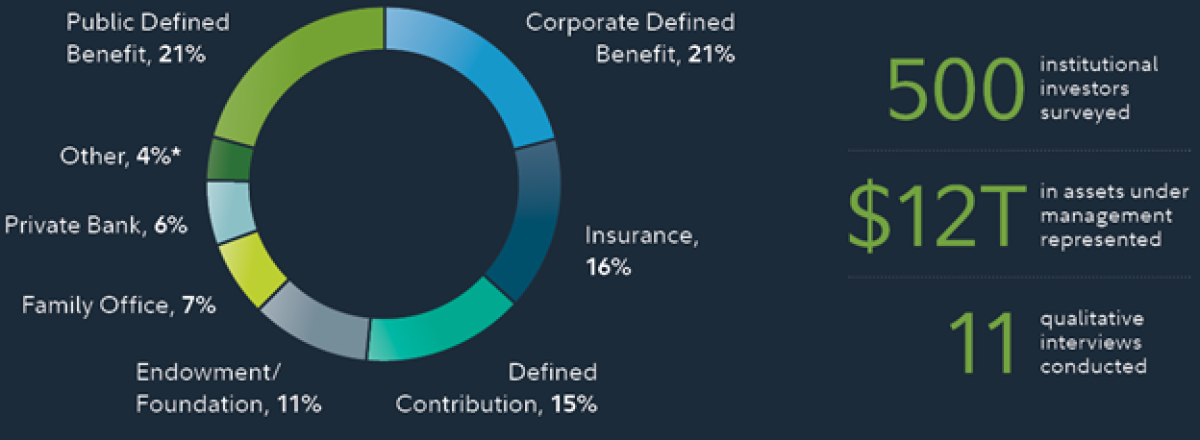
* Includes multi-employer defined benefits (3%) and sovereign wealth (1%). Numbers may not total 100% due to rounding.
For almost 20 years, Fidelity has been conducting primary research to understand decision-making among institutional investors and provide a benchmark for firms of varying types and sizes. Using a new framework we call the Investment Innovators Curve, this year’s study is designed to help firms define and understand the philosophical drivers of their organization’s processes and investment approach.
This framework has been adapted from the diffusion of innovations theory, which identifies how innovative ideas spread. One part of the theory categorizes people and organizations based on how readily they adopt new ideas, placing them on an adoption curve (Exhibit 1).1 We believe that adapting and applying this theory in the context of investment management can provide institutions with new and meaningful insights into the levers that they and their peers push on while pursuing their portfolio objectives.
Exhibit 1: Diffusion of innovations theory suggests a distribution of how quickly segments of the population adopt new ideas. Our Investment Innovators Curve proposes that organizations tend to fall primarily into one of these five categories and build their investment processes accordingly.
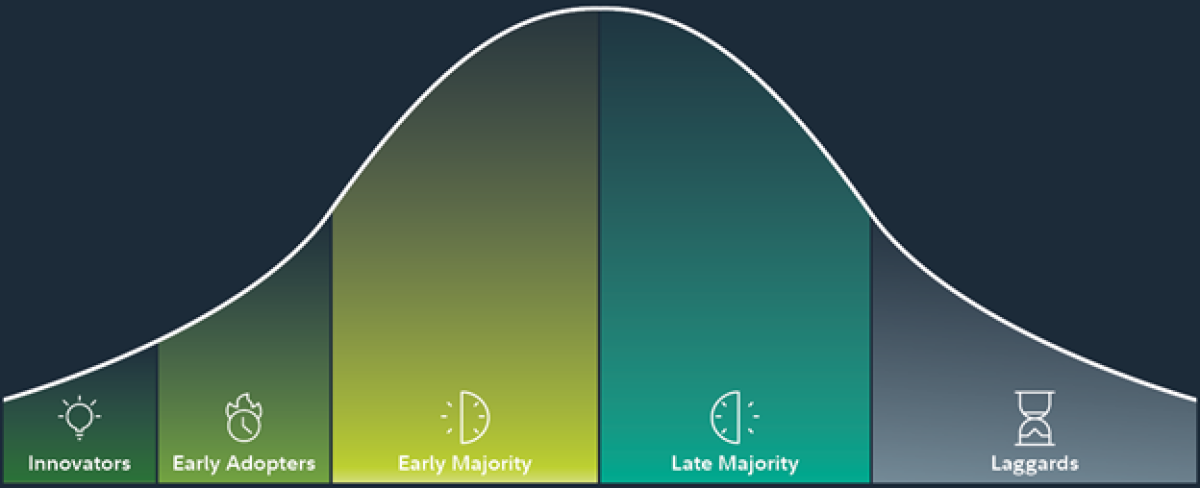
From DIFFUSION OF INNOVATIONS by Everett M. Rogers. Copyright 1962, 1971, 1983 by The Free Press, A Division of Simon & Schuster, Inc. Copyright 1995, 2003 by Everett M. Rogers. Reprinted by permission of Simon & Schuster, Inc. All rights reserved.
Institutions self-select their placement on the Investment Innovators Curve
To this end, the 2021 Institutional Investor Innovation Study asked respondents to select their firm’s placement in an innovation category, based on their organization’s ability and willingness to experiment with new investment approaches and asset classes. Almost two-thirds placed their institutions in the middle as either Early Majority (33%) or Late Majority (31%). However, an analysis of segments at the “tails” of this curve—made up of Innovators (5%) and Early Adopters (18%) at one end and Laggards (13%) at the other—demonstrates how widely investment and decision-making approaches can differ depending on an organization’s orientation around innovation. Importantly, no single part of the curve is made up of a specific institution type or size, supporting the notion that this new dimension of innovation can help firms think differently about how they define their peer groups and related best practices.
Understand your firm’s innovation orientation*
By referencing the following definitions from this year’s study, investment leaders can consider where their organizations sit on the Investment Innovators Curve.
- Innovators: “We are frequently one of the first to try a new asset class or investment approach, even if it’s extremely new and/or unproven.”
- Early Adopters: “We are not the first to try a new asset class or investment approach, but will quickly follow if we notice others are trying it.”
- Early Majority: “We are curious about new asset classes or investment approaches, but are more pragmatic. We’ll wait until it’s more common/established before investing.”
- Late Majority: “We adopt a new asset class or investment approach out of necessity. Once it’s mainstream and has clear, demonstrated value, we’ll invest in it.”
- Laggards: “We are very risk averse when adding new asset classes or investment approaches to our portfolio. We would rather be late to a new investing trend than bear the potential risks involved with new approaches.”
Shifting macroeconomic environment creates new challenges
Many institutions in this year’s study anticipate downward pressure on their ability to outperform against targets in the years to come, which puts urgency around reflecting on and reaffirming whether your firm’s investment philosophy and processes are aligned with your portfolio’s desired outcomes. To date, firms have benefited from a decade of double-digit, beta-driven returns; the S&P 500 ended 2020 with a 10-year annualized return rate of 13.9%.2 Even amid the uncertainty of the pandemic, many have been able to capitalize on strong equity markets, lower interest rates, and favorable monetary policy (Exhibit 2).
However, there is a growing belief that beta may not provide the same strong tailwinds going forward. Only half of those we surveyed feel confident their organizations can achieve their required rate of return over the next three years. Additionally, lower interest rates that helped buoy equity markets have pushed institutions out on the risk spectrum in search of better returns, to the point that some are now uncomfortable (Exhibit 3).
Institutions at either end of the innovators curve may be experiencing this discomfort for different reasons. Forty-four percent of self-described Laggards report concerns around yield generation (vs. 38% of Innovators/Early Adopters)3 and one-quarter cite risk management (vs. 19%) as a major challenge for their portfolios. Conversely, Innovators/Early Adopters are more likely to find it increasingly difficult to source differentiated ideas (28% vs. 21% of Laggards). The investing philosophies that underpin these segments will influence how they manage through the anticipated inflection point in the markets.
Exhibit 2: Actual returns outperformed targets, but many are not confident they will hit targets in the coming years.
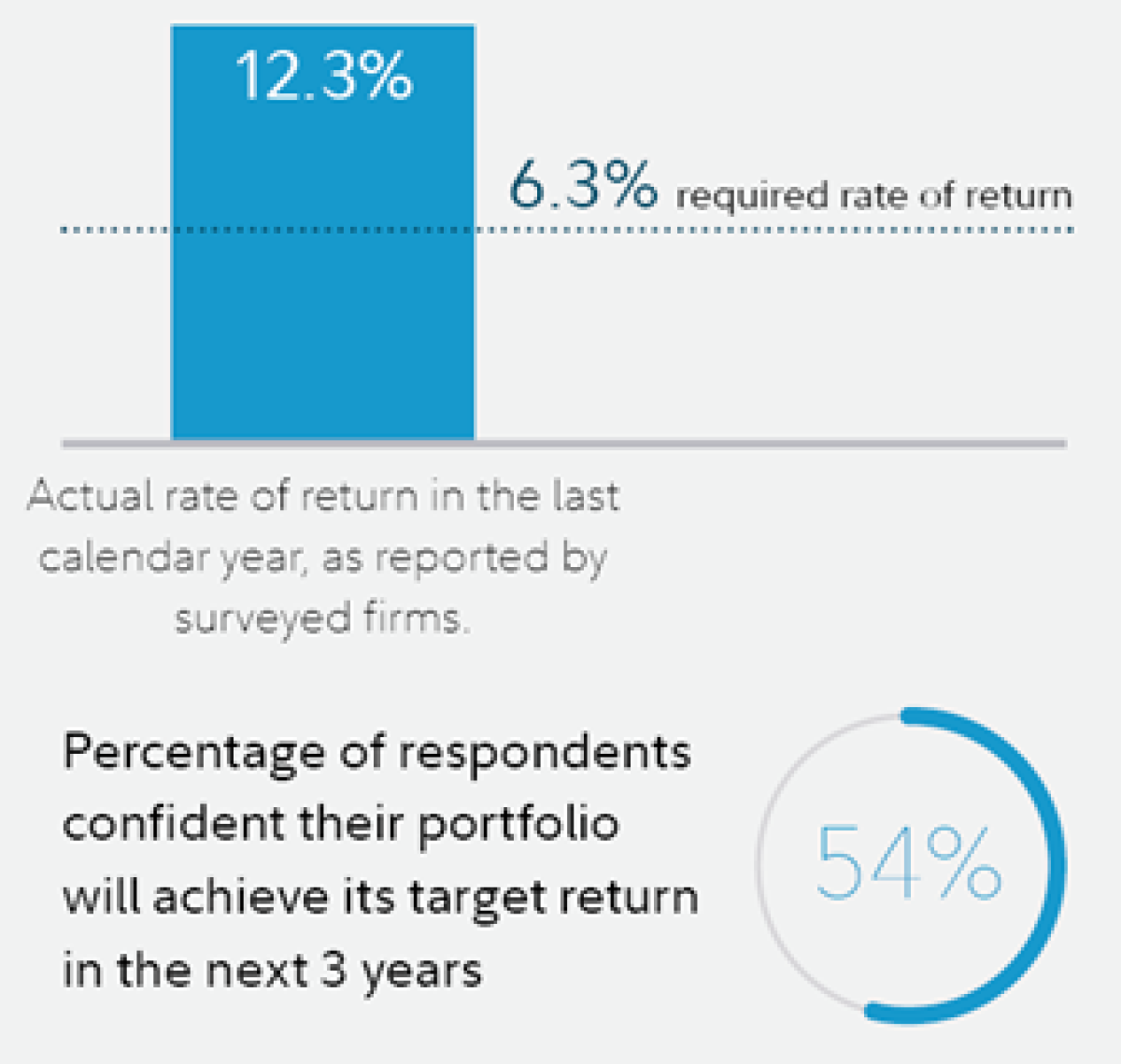
Past performance is no guarantee of future results.
Survey questions: What is your required rate of return? Open-ended %.
What was your actual rate of return in the last calendar year? Open-ended %.
How confident are you that your portfolio will achieve its target return in the next 3 years? 1–5 scale. Not at all optimistic (1) to very optimistic (5).
Exhibit 3: Many institutions are poised to reassess their limit for taking on portfolio risk.
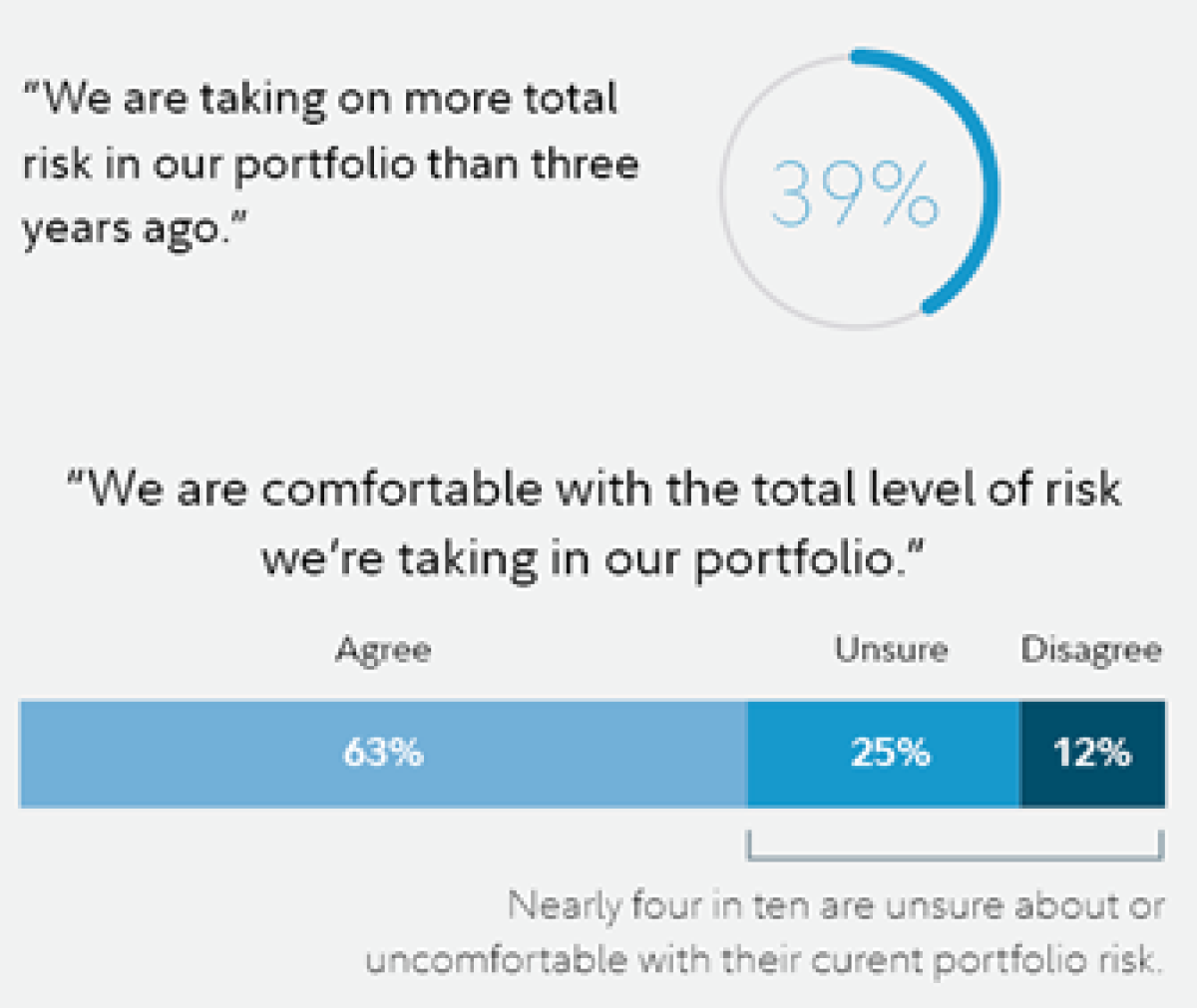
Survey question: To what extent do you agree with the following statements? 1–5 scale. Strongly disagree (1) to strongly agree (5).
Institutions at either end of the curve approach risk and portfolio management differently
With higher target returns (6.8% vs 5.7%) and excess return expectations (3.3% vs 2.5%), Innovators/Early Adopters report an investment edge compared to Laggards. Their placement on the innovators curve aligns with their more optimistic performance outlook and with how they structure and manage their portfolios and teams. In order to achieve potentially higher returns, Innovators/Early Adopters lean further into alternatives, and they expect to increase their allocation toward
active and non-traditional passive (e.g., factor-based investing) strategies over the next few years (Exhibit 4). By comparison, Laggards have limited risk by weighting portfolios more heavily toward traditional asset classes and have more of a home country bias for U.S. equity (35%) and U.S. investment-grade fixed income (21%) (see Appendix). Additionally, with almost 3 in 10 expecting to increase their allocation toward traditional, cap-weighted passive approaches by 2025, Laggards see less imperative to take on the risk that accompanies actively managed or non-traditional passive approaches.
Exhibit 4: Innovators’/Early Adopters’ portfolio structure leans into alternatives and active, non-traditional approaches.
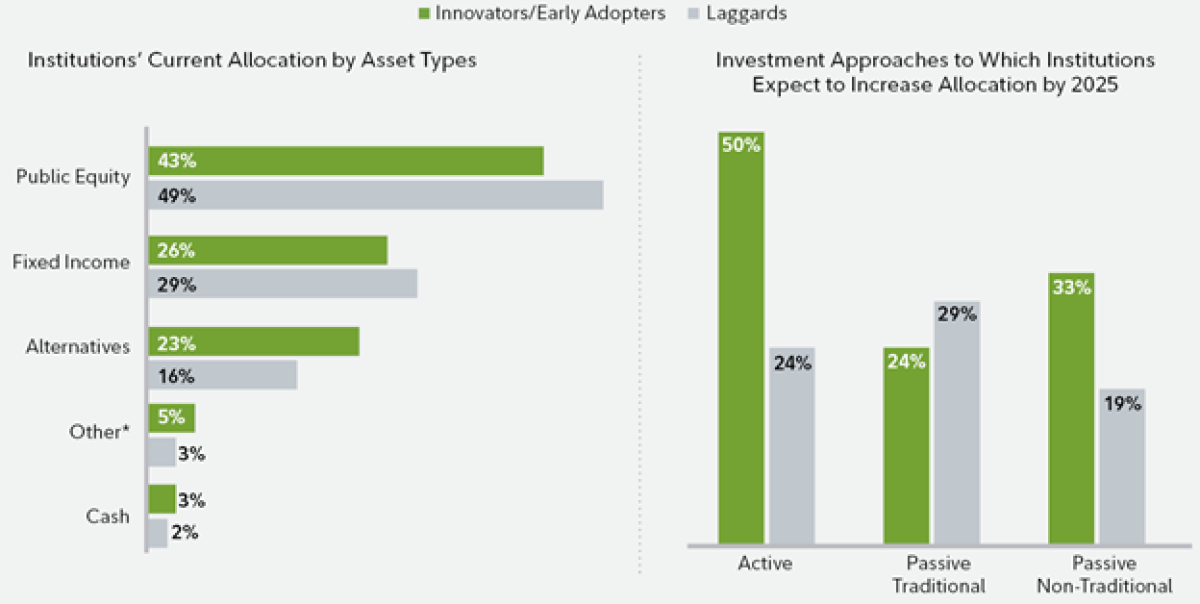
* Multi-Asset and Digital Assets, Numbers may not total 100% due to rounding. Survey questions: What is your current allocation to the following asset types? What direction of change do you expect with each allocation by 2025? Scale of 1 (significant decrease from today) to 5 (significant increase from today); 3 no change from today. “Significant” defined as ≥500 basis point change in allocation.
The vast majority (93%) of Innovators/Early Adopters fundamentally believe there is value in short-term investment opportunities, and they enjoy wider discretion when making tactical portfolio changes. These institutions are also able to lean on asset managers with flexible mandates (42%) and tap into internally managed special accounts (21%). Additionally, almost one-quarter (24%) report that asset class leads have discretion to make tactical adjustments when they see fit (Exhibit 5). In support of this more dynamic decision-making model and their efforts to continually source new investment ideas, 57% report that deep relationships with asset manager partners positively impact their overall investment performance (vs. 48% of Laggards).
Exhibit 5: Innovators/Early Adopters have broader mandates that allow them to manage portfolios dynamically.
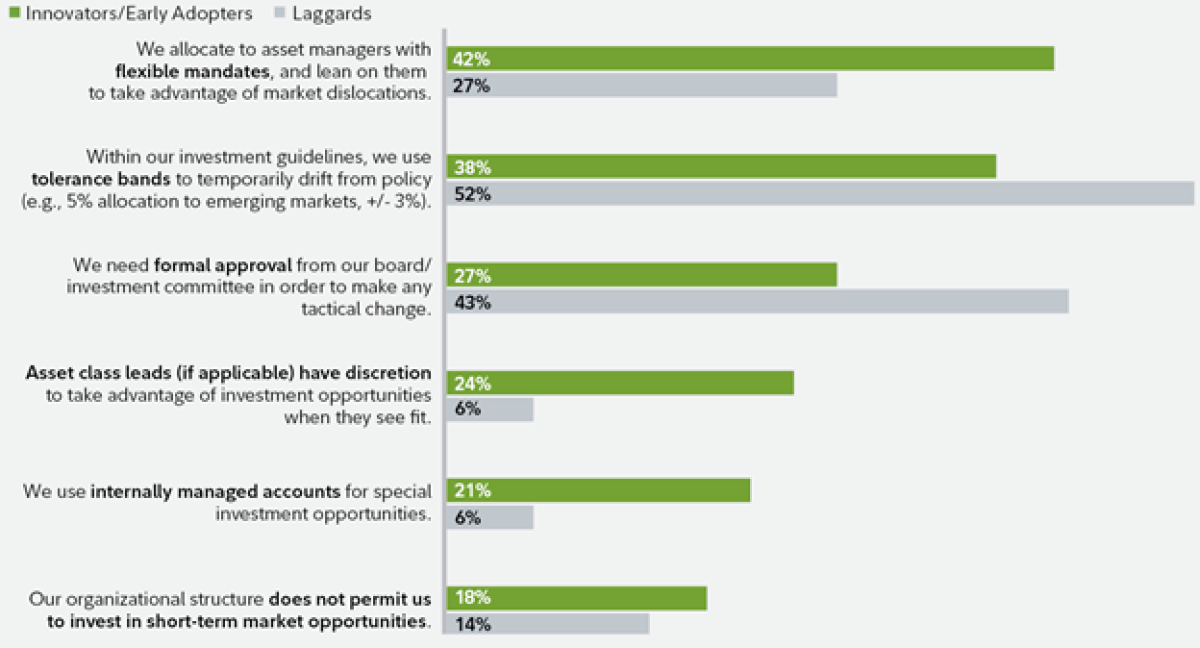
Survey question: How does your organization take advantage of tactical investment opportunities (deliberate deviations from policy weights, typically for periods of less than three years)? Select all that apply.
In contrast, although 70% of self-described Laggards recognize the value in tactical adjustments, many are limited by a more restrictive decision-making model that requires investment committee oversight and limits drift within tolerance bands. As a result, where Innovators/Early Adopters spend significant time and resources building deep relationships with key external partners, our research shows that Laggards instead focus their time on activities that lead to organizational “alpha.” For example, almost two-thirds believe that reducing portfolio costs via internal management or fee concessions would have a strong positive impact on their overall investment performance (vs. 54% of Innovators/Early Adopters). This internal focus on organizational efficiency can also involve optimizing headcount and working more closely with their investment committee.
Reflect on, identify, and benchmark your philosophical peers
There is no right or wrong approach to innovation; institutions at either end of the Investment Innovators Curve have different overarching philosophies and as a result, will make different trade-offs when it comes to investment decisions and organizational processes. With macroeconomic changes potentially on the horizon, organizations are beginning to see headwinds that will pressure them to squeeze returns out of lower yields and with a higher risk profile. This may be a natural time for reflection on how your firm will navigate these changes.
Consider these next steps as you determine whether the Investment Innovators Curve can be a valuable lens for understanding your organization:
- Use the innovators' curve framework as a starting point for discussing and agreeing on your firm’s investment philosophy and its inherent trade-offs.
- Explore best practices within your philosophical peer group to better understand emerging trends or potential changes you need to make in order to achieve return targets.
- Incorporate this new dimension into how your organization evaluates itself; build a plan to consistently benchmark your portfolio and organizational performance against your peers on the Investment Innovators Curve.
To learn more about how your organization can benchmark itself against peers on the Investment Innovators Curve, please visit i.fidelity.com/innovation.
Appendix
Laggards favor traditional asset classes and have a home country bias.
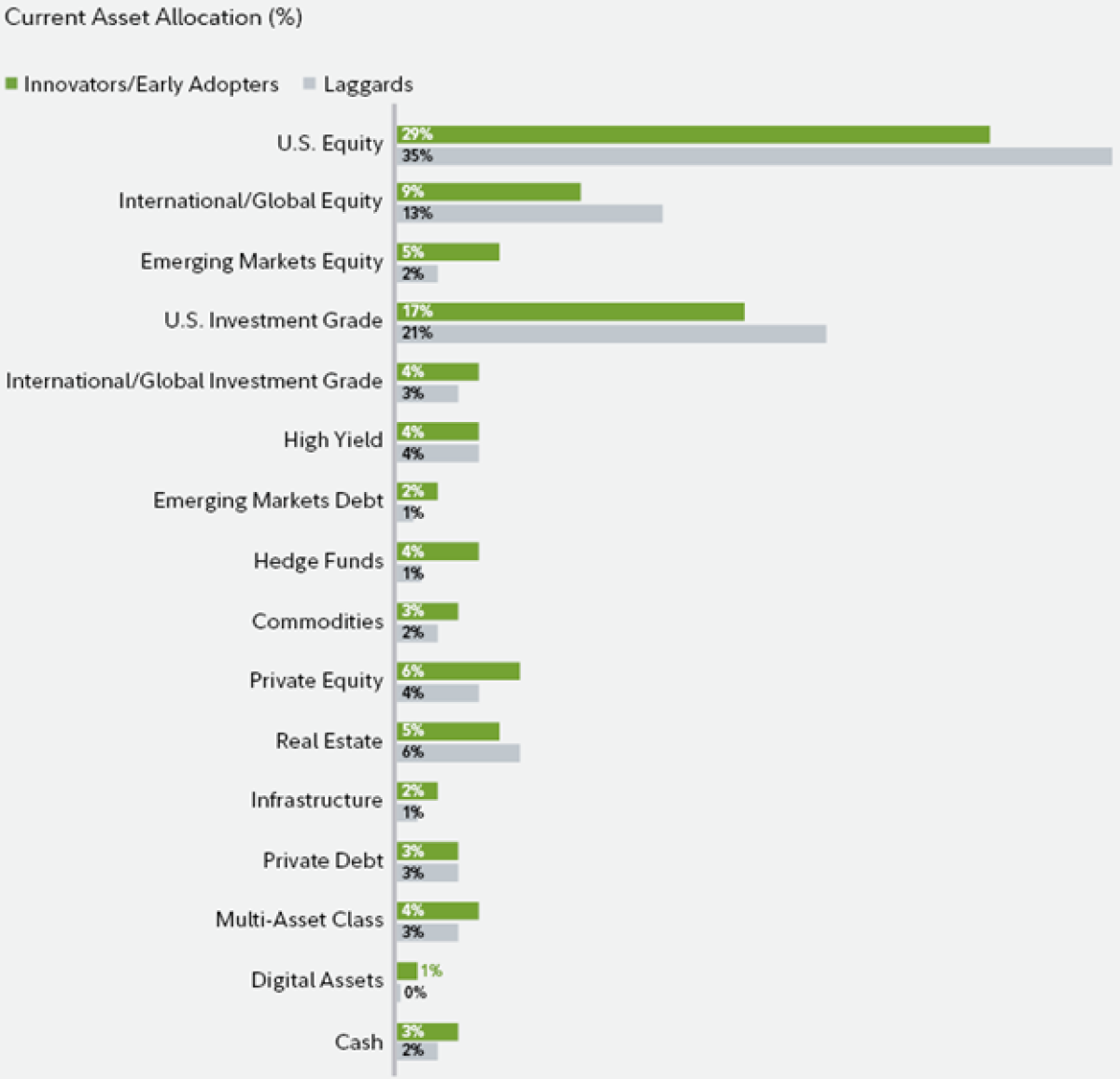
Endnotes
- From DIFFUSION OF INNOVATIONS by Everett M. Rogers. Copyright 1962, 1971, 1983 by The Free Press, A Division of Simon & Schuster, Inc. Copyright 1995, 2003 by Everett M. Rogers.
- Not intended to represent the performance of any Fidelity fund. The S&P 500 Index measures the performance of 500 widely held stocks in U.S. equity market. Source: Morningstar, as of December 31, 2020.
- Innovators and Early Adopters categories were combined to create a meaningful sample size for profiling in this report.
About the Author:
Steve Benjamin is the Head of Market and Business Intelligence at Fidelity Institutional (FI), the Fidelity Investments business that offers financial professionals and institutions access to the investment, technology, and platform solutions they need to service their clients and grow their businesses. Fidelity Investments is a leading provider of investment management, retirement planning, portfolio guidance, brokerage, benefits outsourcing, and other financial products and services to institutions, financial intermediaries, and individuals.
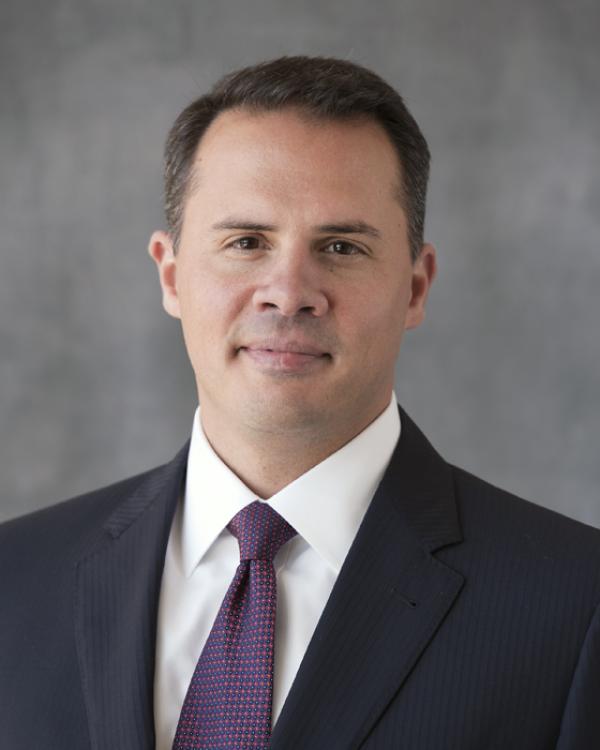
In this role, Mr. Benjamin oversees the team conducting primary and secondary research on markets, customers, and competitors. This research is used to inform strategic business decisions such as distribution model design, sales and profitability forecasting, product development, and the client engagement model. The team also uses their research to develop innovative thought leadership for our clients, employees, and the media.
Prior to joining Fidelity in 2007, Mr. Benjamin was managing director of portfolio construction at Private Capital Management (PCM), a Legg Mason Company. Before joining PCM in 2006, he spent three years with OFI Institutional, building out the firm’s market research and strategic planning capabilities. Previously, Mr. Benjamin spent six years with MFS Investment Management in product management, performance analysis, and accounting-related positions. He has been in the financial industry since 1994.
Mr. Benjamin earned his Bachelor of Science degree in marketing from the University of Massachusetts, Dartmouth and his master’s degree in international affairs from the Fletcher School of Law and Diplomacy at Tuft’s University. He is also a CFA® charter holder, a Chartered Alternative Investment Analyst (CAIA), and holds the Financial Industry Regulatory Authority (FINRA) Series 7, 24, and 63 registrations.
Methodology
Unless otherwise noted, all data are from the 2021 Fidelity Institutional Innovation Study, which polled chief executive officers, chief investment officers, treasurers, and other investment executives at 500 institutions in the U.S. At the time of the survey, these institutions represented $12T (USD) in assets under management, across public sector defined benefit plans, corporate defined benefit plans, insurance companies, defined contribution plan sponsors, endowments and foundations, family offices, private banks, and sovereign wealth funds. Respondents were asked a range of questions about their portfolio objectives, market perspectives, asset allocation, investment philosophy, and investment process. Fidelity Asset Management Solutions (FAMS) conducted the survey from May to July 2021. The survey was executed in association with global research consultancy CoreData Research. All respondents completed an online questionnaire, which was then supplemented by 11 in-depth qualitative interviews with survey respondents at pensions, as well as with endowments and foundations.
Disclaimer: For investment professional or institutional use.
Information provided in this document is for informational and educational purposes only. To the extent any investment information in this material is deemed to be a recommendation, it is not meant to be impartial investment advice or advice in a fiduciary capacity and is not intended to be used as a primary basis for you or your client’s investment decisions. Fidelity and its representatives may have a conflict of interest in the products or services mentioned in this material because they have a financial interest in them, and receive compensation, directly or indirectly, in connection with the management, distribution, and/or servicing of these products or services, including Fidelity funds, certain third-party funds and products, and certain investment services.
Information presented herein is for discussion and illustrative purposes only and is not a recommendation or an offer or solicitation to buy or sell any securities. Views expressed are as of October 2021, based on the information available at that time, and may change based on market and other conditions. Unless otherwise noted, the opinions provided are those of the author and not necessarily those of Fidelity Investments or its affiliates. Fidelity does not assume any duty to update any of the information.
Investment decisions should be based on an individual’s own goals, time horizon, and tolerance for risk. Nothing in this content should be considered to be legal or tax advice, and you are encouraged to consult your own lawyer, accountant, or other advisor before making any financial decision.
Indexes are unmanaged. It is not possible to invest directly in an index.
Investing involves risk, including risk of loss.
Past performance and dividend rates are historical and do not guarantee future results.
Diversification and asset allocation do not ensure a profit or guarantee against loss.
Third-party marks are the property of their respective owners; all other marks are the property of FMR LLC.




